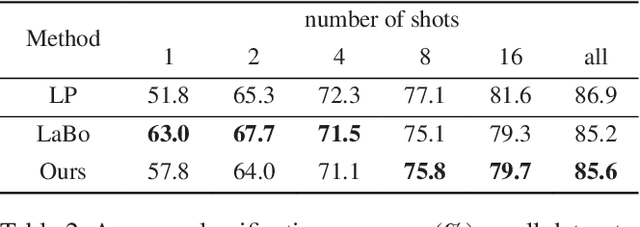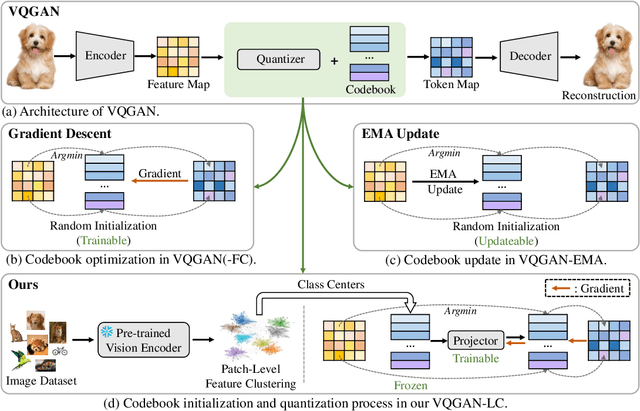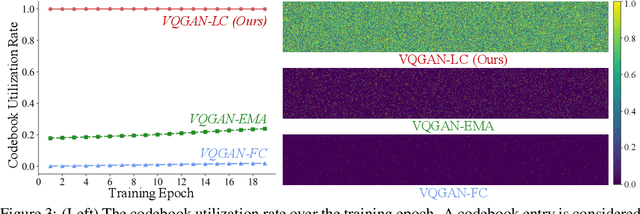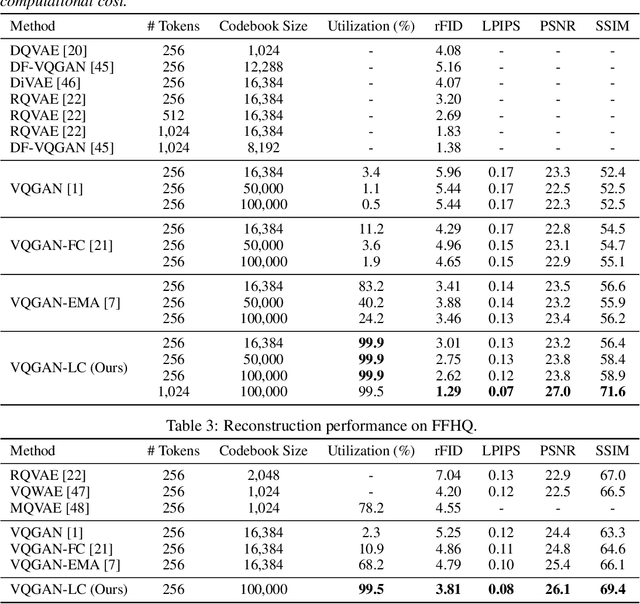Yanye Lu
Novel Extraction of Discriminative Fine-Grained Feature to Improve Retinal Vessel Segmentation
May 06, 2025Abstract:Retinal vessel segmentation is a vital early detection method for several severe ocular diseases. Despite significant progress in retinal vessel segmentation with the advancement of Neural Networks, there are still challenges to overcome. Specifically, retinal vessel segmentation aims to predict the class label for every pixel within a fundus image, with a primary focus on intra-image discrimination, making it vital for models to extract more discriminative features. Nevertheless, existing methods primarily focus on minimizing the difference between the output from the decoder and the label, but ignore fully using feature-level fine-grained representations from the encoder. To address these issues, we propose a novel Attention U-shaped Kolmogorov-Arnold Network named AttUKAN along with a novel Label-guided Pixel-wise Contrastive Loss for retinal vessel segmentation. Specifically, we implement Attention Gates into Kolmogorov-Arnold Networks to enhance model sensitivity by suppressing irrelevant feature activations and model interpretability by non-linear modeling of KAN blocks. Additionally, we also design a novel Label-guided Pixel-wise Contrastive Loss to supervise our proposed AttUKAN to extract more discriminative features by distinguishing between foreground vessel-pixel pairs and background pairs. Experiments are conducted across four public datasets including DRIVE, STARE, CHASE_DB1, HRF and our private dataset. AttUKAN achieves F1 scores of 82.50%, 81.14%, 81.34%, 80.21% and 80.09%, along with MIoU scores of 70.24%, 68.64%, 68.59%, 67.21% and 66.94% in the above datasets, which are the highest compared to 11 networks for retinal vessel segmentation. Quantitative and qualitative results show that our AttUKAN achieves state-of-the-art performance and outperforms existing retinal vessel segmentation methods. Our code will be available at https://github.com/stevezs315/AttUKAN.
SuperCL: Superpixel Guided Contrastive Learning for Medical Image Segmentation Pre-training
Apr 20, 2025Abstract:Medical image segmentation is a critical yet challenging task, primarily due to the difficulty of obtaining extensive datasets of high-quality, expert-annotated images. Contrastive learning presents a potential but still problematic solution to this issue. Because most existing methods focus on extracting instance-level or pixel-to-pixel representation, which ignores the characteristics between intra-image similar pixel groups. Moreover, when considering contrastive pairs generation, most SOTA methods mainly rely on manually setting thresholds, which requires a large number of gradient experiments and lacks efficiency and generalization. To address these issues, we propose a novel contrastive learning approach named SuperCL for medical image segmentation pre-training. Specifically, our SuperCL exploits the structural prior and pixel correlation of images by introducing two novel contrastive pairs generation strategies: Intra-image Local Contrastive Pairs (ILCP) Generation and Inter-image Global Contrastive Pairs (IGCP) Generation. Considering superpixel cluster aligns well with the concept of contrastive pairs generation, we utilize the superpixel map to generate pseudo masks for both ILCP and IGCP to guide supervised contrastive learning. Moreover, we also propose two modules named Average SuperPixel Feature Map Generation (ASP) and Connected Components Label Generation (CCL) to better exploit the prior structural information for IGCP. Finally, experiments on 8 medical image datasets indicate our SuperCL outperforms existing 12 methods. i.e. Our SuperCL achieves a superior performance with more precise predictions from visualization figures and 3.15%, 5.44%, 7.89% DSC higher than the previous best results on MMWHS, CHAOS, Spleen with 10% annotations. Our code will be released after acceptance.
Exploiting Inherent Class Label: Towards Robust Scribble Supervised Semantic Segmentation
Mar 18, 2025Abstract:Scribble-based weakly supervised semantic segmentation leverages only a few annotated pixels as labels to train a segmentation model, presenting significant potential for reducing the human labor involved in the annotation process. This approach faces two primary challenges: first, the sparsity of scribble annotations can lead to inconsistent predictions due to limited supervision; second, the variability in scribble annotations, reflecting differing human annotator preferences, can prevent the model from consistently capturing the discriminative regions of objects, potentially leading to unstable predictions. To address these issues, we propose a holistic framework, the class-driven scribble promotion network, for robust scribble-supervised semantic segmentation. This framework not only utilizes the provided scribble annotations but also leverages their associated class labels to generate reliable pseudo-labels. Within the network, we introduce a localization rectification module to mitigate noisy labels and a distance perception module to identify reliable regions surrounding scribble annotations and pseudo-labels. In addition, we introduce new large-scale benchmarks, ScribbleCOCO and ScribbleCityscapes, accompanied by a scribble simulation algorithm that enables evaluation across varying scribble styles. Our method demonstrates competitive performance in both accuracy and robustness, underscoring its superiority over existing approaches. The datasets and the codes will be made publicly available.
Universal Image Restoration Pre-training via Degradation Classification
Jan 26, 2025Abstract:This paper proposes the Degradation Classification Pre-Training (DCPT), which enables models to learn how to classify the degradation type of input images for universal image restoration pre-training. Unlike the existing self-supervised pre-training methods, DCPT utilizes the degradation type of the input image as an extremely weak supervision, which can be effortlessly obtained, even intrinsic in all image restoration datasets. DCPT comprises two primary stages. Initially, image features are extracted from the encoder. Subsequently, a lightweight decoder, such as ResNet18, is leveraged to classify the degradation type of the input image solely based on the features extracted in the first stage, without utilizing the input image. The encoder is pre-trained with a straightforward yet potent DCPT, which is used to address universal image restoration and achieve outstanding performance. Following DCPT, both convolutional neural networks (CNNs) and transformers demonstrate performance improvements, with gains of up to 2.55 dB in the 10D all-in-one restoration task and 6.53 dB in the mixed degradation scenarios. Moreover, previous self-supervised pretraining methods, such as masked image modeling, discard the decoder after pre-training, while our DCPT utilizes the pre-trained parameters more effectively. This superiority arises from the degradation classifier acquired during DCPT, which facilitates transfer learning between models of identical architecture trained on diverse degradation types. Source code and models are available at https://github.com/MILab-PKU/dcpt.
V2C-CBM: Building Concept Bottlenecks with Vision-to-Concept Tokenizer
Jan 09, 2025



Abstract:Concept Bottleneck Models (CBMs) offer inherent interpretability by initially translating images into human-comprehensible concepts, followed by a linear combination of these concepts for classification. However, the annotation of concepts for visual recognition tasks requires extensive expert knowledge and labor, constraining the broad adoption of CBMs. Recent approaches have leveraged the knowledge of large language models to construct concept bottlenecks, with multimodal models like CLIP subsequently mapping image features into the concept feature space for classification. Despite this, the concepts produced by language models can be verbose and may introduce non-visual attributes, which hurts accuracy and interpretability. In this study, we investigate to avoid these issues by constructing CBMs directly from multimodal models. To this end, we adopt common words as base concept vocabulary and leverage auxiliary unlabeled images to construct a Vision-to-Concept (V2C) tokenizer that can explicitly quantize images into their most relevant visual concepts, thus creating a vision-oriented concept bottleneck tightly coupled with the multimodal model. This leads to our V2C-CBM which is training efficient and interpretable with high accuracy. Our V2C-CBM has matched or outperformed LLM-supervised CBMs on various visual classification benchmarks, validating the efficacy of our approach.
Spike2Former: Efficient Spiking Transformer for High-performance Image Segmentation
Dec 19, 2024



Abstract:Spiking Neural Networks (SNNs) have a low-power advantage but perform poorly in image segmentation tasks. The reason is that directly converting neural networks with complex architectural designs for segmentation tasks into spiking versions leads to performance degradation and non-convergence. To address this challenge, we first identify the modules in the architecture design that lead to the severe reduction in spike firing, make targeted improvements, and propose Spike2Former architecture. Second, we propose normalized integer spiking neurons to solve the training stability problem of SNNs with complex architectures. We set a new state-of-the-art for SNNs in various semantic segmentation datasets, with a significant improvement of +12.7% mIoU and 5.0 efficiency on ADE20K, +14.3% mIoU and 5.2 efficiency on VOC2012, and +9.1% mIoU and 6.6 efficiency on CityScapes.
Low-Rank Mixture-of-Experts for Continual Medical Image Segmentation
Jun 19, 2024Abstract:The primary goal of continual learning (CL) task in medical image segmentation field is to solve the "catastrophic forgetting" problem, where the model totally forgets previously learned features when it is extended to new categories (class-level) or tasks (task-level). Due to the privacy protection, the historical data labels are inaccessible. Prevalent continual learning methods primarily focus on generating pseudo-labels for old datasets to force the model to memorize the learned features. However, the incorrect pseudo-labels may corrupt the learned feature and lead to a new problem that the better the model is trained on the old task, the poorer the model performs on the new tasks. To avoid this problem, we propose a network by introducing the data-specific Mixture of Experts (MoE) structure to handle the new tasks or categories, ensuring that the network parameters of previous tasks are unaffected or only minimally impacted. To further overcome the tremendous memory costs caused by introducing additional structures, we propose a Low-Rank strategy which significantly reduces memory cost. We validate our method on both class-level and task-level continual learning challenges. Extensive experiments on multiple datasets show our model outperforms all other methods.
Scaling the Codebook Size of VQGAN to 100,000 with a Utilization Rate of 99%
Jun 17, 2024



Abstract:In the realm of image quantization exemplified by VQGAN, the process encodes images into discrete tokens drawn from a codebook with a predefined size. Recent advancements, particularly with LLAMA 3, reveal that enlarging the codebook significantly enhances model performance. However, VQGAN and its derivatives, such as VQGAN-FC (Factorized Codes) and VQGAN-EMA, continue to grapple with challenges related to expanding the codebook size and enhancing codebook utilization. For instance, VQGAN-FC is restricted to learning a codebook with a maximum size of 16,384, maintaining a typically low utilization rate of less than 12% on ImageNet. In this work, we propose a novel image quantization model named VQGAN-LC (Large Codebook), which extends the codebook size to 100,000, achieving an utilization rate exceeding 99%. Unlike previous methods that optimize each codebook entry, our approach begins with a codebook initialized with 100,000 features extracted by a pre-trained vision encoder. Optimization then focuses on training a projector that aligns the entire codebook with the feature distributions of the encoder in VQGAN-LC. We demonstrate the superior performance of our model over its counterparts across a variety of tasks, including image reconstruction, image classification, auto-regressive image generation using GPT, and image creation with diffusion- and flow-based generative models. Code and models are available at https://github.com/zh460045050/VQGAN-LC.
Beyond Text: Frozen Large Language Models in Visual Signal Comprehension
Mar 12, 2024



Abstract:In this work, we investigate the potential of a large language model (LLM) to directly comprehend visual signals without the necessity of fine-tuning on multi-modal datasets. The foundational concept of our method views an image as a linguistic entity, and translates it to a set of discrete words derived from the LLM's vocabulary. To achieve this, we present the Vision-to-Language Tokenizer, abbreviated as V2T Tokenizer, which transforms an image into a ``foreign language'' with the combined aid of an encoder-decoder, the LLM vocabulary, and a CLIP model. With this innovative image encoding, the LLM gains the ability not only for visual comprehension but also for image denoising and restoration in an auto-regressive fashion-crucially, without any fine-tuning. We undertake rigorous experiments to validate our method, encompassing understanding tasks like image recognition, image captioning, and visual question answering, as well as image denoising tasks like inpainting, outpainting, deblurring, and shift restoration. Code and models are available at https://github.com/zh460045050/V2L-Tokenizer.
Scribble Hides Class: Promoting Scribble-Based Weakly-Supervised Semantic Segmentation with Its Class Label
Feb 27, 2024



Abstract:Scribble-based weakly-supervised semantic segmentation using sparse scribble supervision is gaining traction as it reduces annotation costs when compared to fully annotated alternatives. Existing methods primarily generate pseudo-labels by diffusing labeled pixels to unlabeled ones with local cues for supervision. However, this diffusion process fails to exploit global semantics and class-specific cues, which are important for semantic segmentation. In this study, we propose a class-driven scribble promotion network, which utilizes both scribble annotations and pseudo-labels informed by image-level classes and global semantics for supervision. Directly adopting pseudo-labels might misguide the segmentation model, thus we design a localization rectification module to correct foreground representations in the feature space. To further combine the advantages of both supervisions, we also introduce a distance entropy loss for uncertainty reduction, which adapts per-pixel confidence weights according to the reliable region determined by the scribble and pseudo-label's boundary. Experiments on the ScribbleSup dataset with different qualities of scribble annotations outperform all the previous methods, demonstrating the superiority and robustness of our method.The code is available at https://github.com/Zxl19990529/Class-driven-Scribble-Promotion-Network.
 Add to Chrome
Add to Chrome Add to Firefox
Add to Firefox Add to Edge
Add to Edge